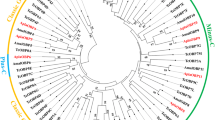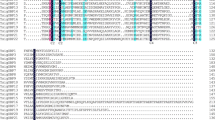Abstract
Odorant binding proteins (OBPs) are believed to be important for transporting semiochemicals through the aqueous sensillar lymph to the olfactory receptor cells within the insect antennal sensilla. In this study, three new putative OBP genes, MmedOBP8-10, were identified from a Microplitis mediator (Hymenoptera: Braconidae) antennal cDNA library. Quantitative real-time PCR (qRT-PCR) analysis revealed that all three of the OBP genes were expressed mainly in the antennae of adult wasps. The three OBPs were recombinantly expressed in Escherichia coli and purified by Ni ion affinity chromatography. Fluorescence competitive binding assays were performed using N-phenyl-naphthylamine as a fluorescent probe and 45 small organic compounds as competitors. These assays demonstrated that the three M. mediator OBPs can bind a broad range of odorant molecules with different binding affinities. They can bind the following ligands: nonane, farnesol, nerolidol, nonanal, β-ionone, acetic ether, and farnesene. In a Y-tube assay with these ligands as odor stimuli and paraffin oil as a control, all ligands, except nerolidol and acetic ether, were able to elicit behavioral responses in adult M. mediator. The wasps were significantly attracted to β-ionone, nonanal, and farnesene and repelled by nonane and farnesol. The results of this work provide insight into the chemosensory functions of the OBPs in M. mediator.



Similar content being viewed by others
References
Arthur AP, Mason PG (1986) Life history and immature stages of the parasitoid Microplitis mediator (Hymenoptera: Braconidae), reared on the bertha armyworm, Mamestra configurata (Lepidoptera: Noctuidae). Can Entomol 118:487–491
Benton R, Vannice KS, Vosshall LB (2007) An essential role for a CD36-related receptor in pheromone detection in Drosophila. Nature 450:289–293
Briand L, Nespoulous C, Huet JC, Takahashi M, Pernollet JC (2001) Ligand binding and physico-chemical properties of ASP2, a recombinant odorant-binding protein from honeybee (Apis mellifera L.). Eur J Biochem 268:752–760
dE Moraes CM, Lewis WJ, Pare PW, Alborn HT, Tumlinson JH (1998) Herbivore-infested plants selectively attract parasitoids. Nature 393:570–573
Du JW (2001) Plant-insect chemical communication and its behavior control. Acta Phytophysiologica Sinica 27:193–200
Gong ZJ, Zhou WW, Yu HZ, Mao CG, Zhang CX, Cheng JA, Zhu ZR (2009) Cloning, expression and functional analysis of a general odorant-binding protein 2 gene of the rice striped stem borer, Chilo suppressalis (Walker) (Lepidoptera: Pyralidae). Insect Mol Biol 18:405–417
Grosse-Wilde E, Svatos A, Krieger J (2006) A pheromone binding protein mediates the bombykol-induced activation of a pheromone receptor in vitro. Chem Senses 31:547–555
Gu SH, Wang WX, Wang GR, Zhang XY, Guo YY, Zhang ZD, Zhou JJ, Zhang YJ (2011) Functional characterization and immunolocalization of odorant binding protein1 in the Lucerne Plant Bug, Adelphocoris lineolatus (GOEZE). Arch Insect Biochem Physiol 77:81–98
Gu SH, Wang SY, Zhang XY, Ji P, Liu JT, Wang GR, Wu KM, Guo YY, Zhou JJ, Zhang YJ (2012) Functional characterizations of chemosensory proteins of the Alfalfa plant Bug Adelphocoris Lineolatus indicate their involvement in host recognition. PLoS ONE 7:e42871
Hooper AM, Dufour S, He X, Muck A, Zhou JJ, Almeida R, Field LM, Svatos A, Pickett JA (2009) High-throughput ESI-MS analysis of binding between the Bombyx mori pheromone-binding protein BmorPBP1, its pheromone components and some analogues. Chem Commun (Camb) 38:5725–5727
Jin X, Ha TS, Smith DP (2008) SNMP is a signaling component required for pheromone sensitivity in Drosophila. Proc Natl Acad Sci U S A 105:10996–11001
Leal WS, Nikonova L, Peng G (1999) Disulfide structure of the pheromone binding protein from the silkworm moth, Bombyx mori. FEBS Lett 464:85–90
Liu SJ, Liu NY, He P, Li ZQ, Dong SL, Mu LF (2012) Molecular characterization, expression patterns, and ligand-binding properties of two odorant-binding protein genes from Orthaga achatina (Butler) (Lepidoptera: Pyralidae). Arch Insect Biochem Physiol 80:123–139
Livak KJ, Schmittgen TD (2001) Analysis of relative gene expression data using real-time quantitative PCR and the 2-ΔΔCt Method. Methods 25:402–408
Pophof B (2004) Pheromone-binding proteins contribute to the activation of olfactory receptor neurons in the silkmoths Antheraea polyphemus and Bombyx mori. Chem Senses 29:117–126
Scaloni A, Monti M, Angeli S, Pelosi P (1999) Structural analysis and disulfide-bridge pairing of two odorant-binding proteins from Bombyx mori. Biochem Biophys Res Co 266:386–391
Shenefelt RD (1973) Braconidae: Microgastrinae and Ichneutae. In: van Vecht J, Shenefelt RD (eds) Hymenopterum catalogus nova edito. W. Junk Publishers, Gravenhage, pp 750–751
Sun YL, Huang LQ, Pelosi P, Wang CZ (2012) Expression in antennae and reproductive organs suggests a dual role of an odorant-binding protein in two sibling Helicoverpa species. PLoS ONE 7:e30040
Syed Z, Ishida Y, Taylor K, Kimbrell DA, Leal WS (2006) Pheromone reception in fruit flies expressing a moth’s odorant receptor. Proc Natl Acad Sci U S A 103:16538–16543
Vogt RG, Riddiford LM (1981) Pheromone binding and inactivation by moth antennae. Nature 293:161–163
Vogt RG, Rybczynski R, Lerner MR (1991) Molecular cloning and sequencing of general-odorant binding proteins GOBP1 and GOBP2 from the tobacco hawk moth Manduca sexta: Comparisons with other insect OBPs and their signal peptides. J Neurosci 11:2972–2984
Yan ZG, Yan YH, Wang CZ (2005) Attractiveness of tobacco volatiles induced by Helicoverpa armigera and Helicoverpa assulta to Campoletis chlorideae. Chin Sci Bull 50:1334–1341
Yu HL, Zhang YJ, Zhang GJ, Guo YY, Gao XW (2006) Taxis responses of parasitoid Microplitis mediator to volatiles of cotton after different treatments. Chinese J Appl Environ Biol 12:809–813
Yu HL, Zhang YJ, Pan WL, Guo YY, Gao XW (2007) Identification of volatiles from field cotton plant under different induction treatments. Chin J Appl Ecol 18:859–864
Yu HL, Zhang YJ, Wyckhuys KAG, Wu KM, Gao XW, Guo YY (2010) Electrophysiological and behavioral responses of Microplitis mediator (Hymenoptera: Braconidae) to caterpillar-induced volatiles from cotton. Environ Entomol 39:600–609
Zhang S, Zhang YJ, Su HH, Gao XW, Guo YY (2009) Identification and expression pattern of putative odorant-binding proteins and chemosensory proteins in antennae of Microplitis mediator (Hymenoptera: Braconidae). Chem Senses 34:503–512
Zhang S, Chen LZ, Gu SH, Cui JJ, Gao XW, Zhang YJ, Guo YY (2011) Binding characterization of recombinant odorant-binding proteins from the parasitic wasp, Microplitis mediator (Hymenoptera: Braconidae). J Chem Ecol 37:189–194
Zhou JJ, Robertson G, He X, Dufour S, Hooper AM, Pickett JA, Keep NH, Field LM (2009) Characterisation of Bombyx mori Odorant-binding proteins reveals that a general odorant-binding protein discriminates between sex pheromone components. J Mol Biol 389:529–545
Zhou JJ, Field LM, He XL (2010) Insect odorant-binding proteins: do they offer an alternative pest control strategy? Outlooks on Pest Management 21:31–34
Acknowledgments
This work was supported by the China National Basic Research Program (2012CB114104) and the National Natural Science Foundation of China (31171858,31272048, and 31321004). YJ Zhang and JJ Zhou acknowledge financial support from the international joint project between China and the UK (31111130203; JP100849). This manuscript has been edited by native English-speaking experts of Elsevier Language Editing Services.
Author information
Authors and Affiliations
Corresponding author
Electronic supplementary material
Below is the link to the electronic supplementary material.
Fig. S1
Expression and purification of MmedOBP8-10 proteins. SDS-PAGE analyses of the recombinant OBP proteins: MmedOBP8, MmedOBP9 and MmedOBP10. Non-induced protein (nip), induced protein (ip), inclusion bodies (ib), supernatant (s), purified protein with tag (ppwt), protein molecular weight marker (m), purified protein without tag (ppwot) and low concentration of supernatant (lcos) (GIF 786 kb)
Rights and permissions
About this article
Cite this article
Li, K., Wang, S., Zhang, K. et al. Odorant Binding Characteristics of Three Recombinant Odorant Binding Proteins in Microplitis mediator (Hymenoptera: Braconidae). J Chem Ecol 40, 541–548 (2014). https://doi.org/10.1007/s10886-014-0458-5
Received:
Revised:
Accepted:
Published:
Issue Date:
DOI: https://doi.org/10.1007/s10886-014-0458-5




